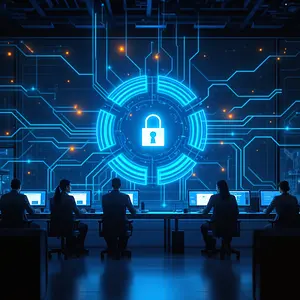IT Training & Support
From onboarding to ongoing assistance, our IT training and support services are designed to empower your users and keep your business running efficiently and securely.
What Is the Role of IT Training and Support in Business Operations?
An IT training and support center is an organization’s digital ecosystem, ensuring that technology investments translate into secure, efficient operations. Whether managing cloud infrastructure, maintaining endpoint security, or navigating enterprise applications, users must understand system functionality to prevent costly errors. Training platforms such as KnowBe4, Pluralsight, and Microsoft Learn deliver scalable solutions for continuous skills development. Support frameworks leverage ITSM tools like ServiceNow and Freshservice, organizing incident resolution workflows and ticket escalation protocols. Think of IT training as a vaccination—it preempts infection by strengthening the immune system, while support acts as the medical response team when illness occurs. Moreover, documented training programs fulfill requirements from frameworks like NIST SP 800-50 and CMMC Level 2, which mandate security awareness initiatives. A structured support system also aligns with ISO/IEC 20000 standards for IT service management, promoting service continuity and user satisfaction. Consequently, both elements are fundamental in reducing human error, strengthening cybersecurity posture, and improving ROI on tech infrastructure.

Why Is Ongoing IT Training Important for Cybersecurity?
Ongoing IT training functions as a proactive safeguard against emerging threats that exploit outdated knowledge. Cybersecurity awareness programs like phishing simulations, password hygiene refreshers, and MFA enrollment walkthroughs reduce exposure to common attack vectors. According to Proofpoint’s 2024 Human Factor Report, 74% of security breaches involve some form of social engineering. Training modules that simulate real-world attack patterns help users recognize malicious tactics before damage occurs. These exercises are flight simulators for pilots, replicating high-risk scenarios without real-world fallout. Moreover, compliance mandates like PCI-DSS (Requirement 12.6) require formal security awareness programs for all employees handling sensitive data. Configuration of learning management systems (LMS) such as Moodle or SAP Litmos should include quiz thresholds, version tracking, and audit logs to meet regulatory scrutiny. Accordingly, training content must evolve quarterly, integrating feedback from incident post-mortems and threat intelligence feeds.
How Can Poor IT Support Lead to Business Disruptions?
In one documented failure, a mid-sized enterprise experienced an email outage after a failed Microsoft 365 security update. The root cause was a miscommunication between the Tier 1 support team and system administrators, who failed to escalate a corrupted policy change. Hours of downtime ensued, halting client communications, disrupting internal workflows, and delaying deliverables. Much like a fire alarm that fails to notify the fire department, the support system collapsed under stress due to a lack of clarity, escalation procedures, and historical documentation. However, a well-structured support system, such as the one adopted by the organization in this case, can prevent such disruptions. It aligns operations with SOC 2 Type II standards, emphasizing service availability and change control documentation, and reduces resolution time by 47%. This restructuring instills a sense of security and confidence in the organization’s operations.
What Makes a Great IT Support Structure?
A responsive, multi-tiered IT support system balances immediacy with expertise. Tier 0 automation resolves common issues using chatbots powered by NLP engines like IBM Watson or Microsoft Power Virtual Agents. Tier 1 technicians address basic troubleshooting, while Tier 2 and Tier 3 escalate more complex problems to engineers or developers. Structuring support as a relay race ensures that the baton passes efficiently without dropping pace. Integration with remote monitoring and management (RMM) platforms like NinjaOne or Atera further enables proactive intervention, detecting system anomalies before users experience them. Moreover, support ticket metadata, including resolution time, recurrence rate, and root cause, must be regularly analyzed to identify systemic issues. SLAs (Service Level Agreements) must be clearly defined, with notification workflows triggered for breaches. Notwithstanding the tools, success hinges on process maturity and staff training.

How Does IT Training Reduce Risk and Enhance Compliance?
IT training programs foster a culture of compliance and risk management. Customized modules aligned with internal policies and industry regulations educate employees on best practices for handling data, using business applications, and reporting incidents. Training dashboards track completion rates, risk scores, and performance trends by department. This comprehensive approach to training, akin to driver’s education, reduces operational and regulatory mishaps. Tools such as KnowBe4’s Risk Score algorithm or Curricula’s adaptive learning modules provide data-driven insights into organizational threat levels. GDPR, HIPAA, and SOX all emphasize the human element of risk, requiring proof of user education. Accordingly, training platforms should integrate with HRIS tools for auto-enrollment, role-based learning paths, and termination triggers. This emphasis on training reassures the audience of the organization’s commitment to compliance and risk management.
What Technologies Support Effective IT Helpdesk Operations?
Modern IT support relies on a range of technologies to ensure efficient and effective operations. Centralized dashboards provide unified visibility into service requests, asset data, and threat intelligence, enabling support teams to manage and prioritize tasks effectively. Ticketing platforms with native mobile apps, real-time analytics, and automated workflows streamline resolution times, improving the overall efficiency of the helpdesk. Predictive analytics tools embedded in support systems forecast ticket surges, allowing for proactive resource allocation and management. These tools, much like an air traffic control tower managing complex movements in real time, enable helpdesk operations to be conducted with visibility, coordination, and precision. Integrations with device management solutions such as Microsoft Endpoint Manager ensure contextual support—technicians see device history, user profile, and system health at ticket creation, enhancing the quality of support provided. Moreover, voice-over-IP (VoIP) systems like 3CX allow live support to integrate with CRM platforms, creating a 360-degree customer view and improving customer service. This comprehensive suite of technologies supports an efficient support system that not only resolves issues but also collects actionable data to optimize infrastructure and strategy.
How Do Support Teams Handle Emerging Technologies?
Support teams must continuously adapt to changes in technology stacks, including containerization, AI integrations, and edge computing. For example, troubleshooting Kubernetes-based applications requires familiarity with command-line tools like kubectl and knowledge of Helm charts, namespace configurations, and cluster state diagnostics. Training labs using platforms like Katacoda or A Cloud Guru simulate these environments for skill development. Think of this as firefighters learning to operate drone-based water cannons—the tools evolve, but the mission remains the same. Accordingly, technical documentation must evolve alongside training materials. Moreover, peer mentoring systems and internal wikis maintain tribal knowledge, ensuring rapid onboarding and knowledge transfer. Ordinarily, organizations relying solely on legacy support models struggle to scale as infrastructure modernizes.
What Happens When IT Training Is Prioritized from Day One?
A managed service provider onboarded a healthcare client with a history of ransomware incidents. The first initiative involved mandatory security training and device hardening protocols. Within three months, phishing report rates improved by 82%, and zero security incidents occurred. Think of this transformation like upgrading from a paper map to a GPS with real-time traffic data—direction is clearer, and detours are managed. Devices were enrolled in mobile device management (MDM) systems with enforced encryption and app allowlisting. PCI-DSS and HIPAA compliance reports align with training and device policy requirements. Accordingly, audits passed with no critical findings, and staff feedback surveys cited improved confidence in handling tech-related scenarios—the investment in foundational training paid operational and reputational dividends.
Why Should Small Businesses Invest in IT Training and Support?
Small businesses face unique constraints—limited personnel, constrained budgets, and rapidly evolving cyber threats. IT training and responsive support systems level the playing field by preventing avoidable disruptions and ensuring secure operations. According to CompTIA’s 2023 report, 58% of small businesses suffered downtime due to a lack of technical knowledge. Moreover, 39% of data breaches in this sector were attributed to untrained staff. Training investments return dividends by reducing support tickets and increasing system reliability. Support tools tailored for SMBs, such as Zoho Desk or GoTo Resolve, offer scalable, affordable solutions with enterprise-grade features. Accordingly, small organizations that embrace IT training and support outperform their peers in operational resilience and customer trust.
Just Two of Our Awesome Client Reviews:
Curtis Lassingame:
⭐️⭐️⭐️⭐️⭐️
“Reno Cyber IT Solutions transformed our support response time from sluggish to lightning fast. Even our part-time staff received cybersecurity training that actually stuck. The team never made us feel small or unimportant, and the follow-ups have been consistent. They are truly a transformative partner.”
Frances Taylor:
⭐️⭐️⭐️⭐️⭐️
“The onboarding training from Reno Cyber IT Solutions was eye-opening. We now have clear protocols, weekly security tips, and live help when needed. Our office hasn’t experienced a single compliance scare since making the switch. The entire experience felt personal and tailored.”
Technology without training is like armor without a knight.
Reno Cyber IT Solutions delivers personalized training, dedicated support, and airtight compliance systems to empower teams of any size.
👉 Learn more about our Managed IT Services and schedule a free consultation today.
👉 Futureproof operations start with the proper guidance—get started now.
Investing in comprehensive IT services that include robust IT asset management is a strategic imperative for modern businesses. Effective asset management goes beyond simply tracking inventory; it encompasses the entire lifecycle of IT assets, from procurement to disposal. This includes meticulous documentation, proactive maintenance, and strategic planning for upgrades and replacements. By understanding the value, utilization, and security posture of each IT asset, organizations can optimize their technology investments, improve operational efficiency, and mitigate potential risks associated with outdated or unmanaged systems.
Furthermore, in an era of increasing cyber threats, integrating cybersecurity into IT asset management is non-negotiable. Knowing precisely what hardware and software are present within the network is the first line of defense against vulnerabilities. IT services that combine asset management with cybersecurity provide a holistic approach, ensuring that all assets are not only accounted for but also secured against potential attacks. This integrated strategy enables businesses to maintain a strong security posture, comply with regulatory requirements, and protect their critical data and operations, ultimately contributing to long-term stability and growth.
Ready to Secure and Support Your Business?
Your Reliable, Compliant, and Secure IT Partner:
Ready to Support and Secure Your Business Every Step of the Way.
